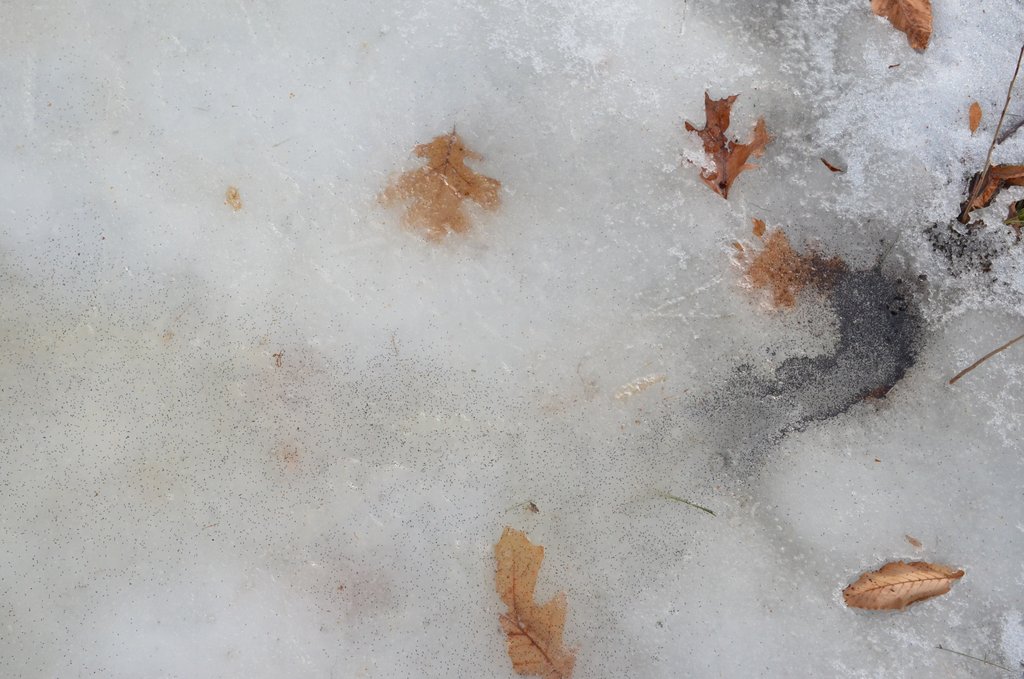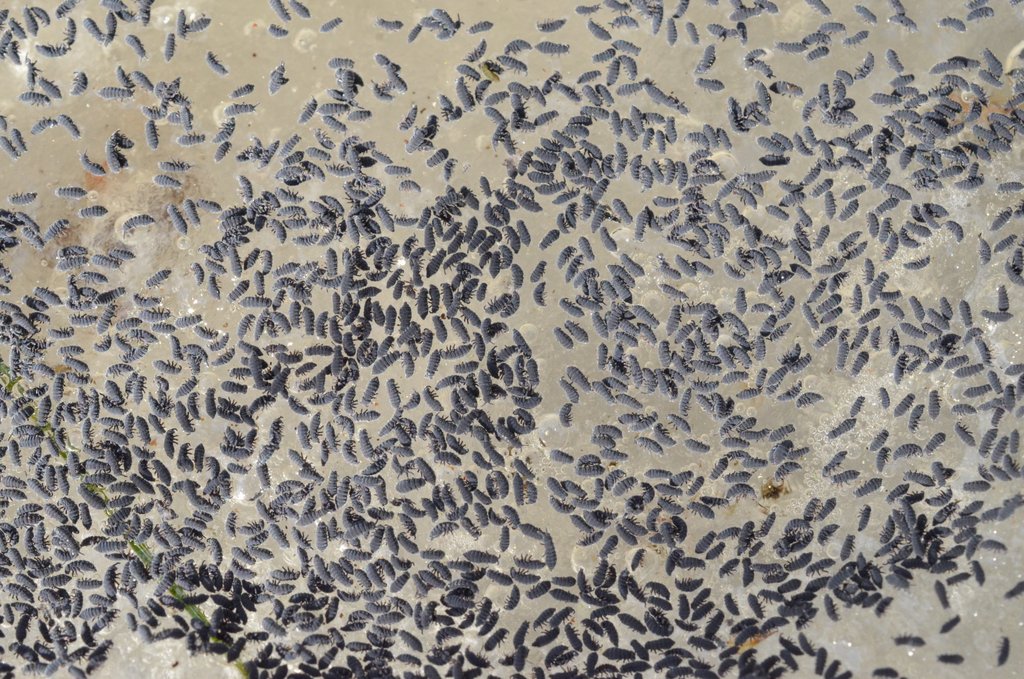Signs of Spring(tails)
While out at the Field School with Crow’s Path last week, some of the kiddos were describing the different signs of spring they’d seen. This week in particular is pretty ridiculous with daytime temperatures well above 40, and the first signs of spring are indeed upon us: sap flow, buds starting to swell, red-winged blackbirds singing, turkey vultures scouring the land for winter kills, and daytime highs in the 40s. Under a warm, clear sky I headed up to Airport Park in Colchester in search of Nyssa sylvatica (link). As I carefully navigated the iced sheet of a trail, my eyes were down more than up, and I caught one of my favorite warm winter day critters: snow fleas.
Snow flea taxonomy
Snow fleas, or springtails, or vermes nwalis – the “snow worm” in Ancient Rome (link) or Hypogastrura nivocola, are tiny arthropods (Arthropoda=joint-legged; the phylum of animals that includes shrimp, butterflies, ants, ticks, spiders, and crabs, among others). Below the phylum Arthropoda is the subphylum Hexapoda, which includes, as the name implies, all the 6-legged arthopods in four classes: insects, Protura, Diplura, and our taxon of interest, Collembola (kolla: glue, embola: belly, referring to the collophore, an appendage on the belly scientists used to think secreted an adhesive: illustration). Lumpers used to group those 4 classes together, while splitters, who are winning this debate, split out the latter 3 classes from Insecta. These three groups include more primitive arthropods that are thought to be the predecessors to modern insects, and lack some derived characteristics of Insecta. Collembola, which includes snow fleas, lack wings and are entognathus, their mouth parts are contained entirely within the head capsule.
Etymology
Their species name, is one of those perfectly descriptive ones; Hypogastrura nivocola translates roughly to: “The snow dweller with a tail under its belly.”
hypo: below;
gastro: stomach;
oura: tail (like Sciurus, the squirrel, which is Greek for shade tail)
nivi: snow
cola: lives in.
Description
While you might not be able to tell from looking at extermintor websites, snow fleas are completely and totally harmless. They’re not even true fleas, and can readily be distinguished from true fleas, which are insects, in a couple of ways. First, true fleas jump about with purpose and direction, propelling themselves with their disproportionately large hind legs (link to description of a related taxa’s jump mechanics). Snow fleas, on the other hand, have a spring loaded furculum, a tail-ish appendage tucked under their abdomen (remember: Hypogastrura). When a potential threat (like your boot) comes near, they evert little anal sacs (check out this photo), which maybe act as grippy landing pads (spring tails careen through the air up to 100x their body length), and activate their furculum, which propels their body up and out, hurtling through space without direction. Additionally, as you well know, fleas suck blood for nourishment, and they do so with long external poking mouth parts. Snow fleas, our gentle soil denizens, have their mouth parts tucked away inside their head, so, unlike with true fleas, they can’t do much in the way of sucking blood. Instead they have a diet similar to earthworms, foraging on detritus and fungi.

Warm weather brought out the snow fleas and then washed them downslope into a pool (Airport Park, Colchester)
When and where they appear
Snow fleas occasionally can be a nuisance in sap buckets. Snow around the base of trees tends to melt out away from the bark as the bark warms the snow. Snow fleas likely use these channels to make their way to the surface of the snow by climbing up the trunks of trees. And when the emerge, they do it in spectacular fashion. You never just see one snow flea. On warm days they move up from below the snow to forage for food exposed by the melting snow in the tens of thousands. Bernd Heinrich found that Collembolans (though not necessarily snow fleas), make up a significant portion of golden-crowned kinglets. I can’t imagine they would pass up an opportunity to feed on this abundant food source. But I’ve also never noticed any birds or other predators going after them.
They’re present in the soil year round, but their purplish black bodies contrasted against the snow make them particularly easy to spot in winter and singularly impossible to find in the summer. They slowly move over the surface of the snow, bouncing sporadically and often accumulating in depressions, especially animal tracks. Most of the woods at Airport Park was free of snow, but the trails, which are compacted into a sheet of ice were still around, but slowly melting. As the ice melted, it washed streams of snow fleas down slope where they were pooling in little drainages. Most still seemed alive, but not sure if they can withstand being submerged in water. They certainly won’t die if entrapped overnight in the water as it freezes. Snow fleas produce a unique glycine-rich protein that acts as a very effective antifreeze, lowering their freezing point by almost 11 degrees F!
References
- How insects survive the cold: molecular mechanisms—a review (link)
-
Jumping mechanisms and performance of snow fleas (Mecoptera, Boreidae) (link)
- Cold jumpers (link)
- Â Overland Migration of Collembola (Hypogastrura nivicola Fitch) Colonies (link)
- Glycine-Rich Antifreeze Proteins from Snow Fleas (link)
- Bugs with bounce (link)
- Winter food of a small insectivorous bird, the golden-crowned kinglet (link)
- Insects attracted to Maple Sap: Observations from Prince Edward Island, Canada (link)





